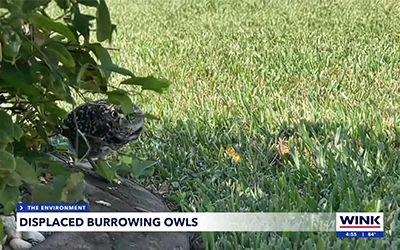How to Help Burrowing Owls Displaced After Hurricanes
Hurricanes Helene and Milton left many burrowing owls homeless, and Pascha Donaldson, a board member of the Cape Coral Wildlife Trust, is working hard to get them back into their burrows.
Donaldson straps on her pink gloves, marches through the tall grass in her boots and turns on her weedwhacker. She’s on a mission.
“I spent eight hours yesterday cleaning burrows, going around the neighborhood,” said Donaldson, who is also the past president of the Cape Coral Friends of Wildlife.
Donaldson said the owls are misplaced because of wind, rain and flooding.
Unlike humans who can repair our homes and clear debris after a hurricane, burrowing owls can’t do that work themselves.
“If grass has grown over it, or the ‘Cape Coral snow,’ the little purple flowers have covered the burrow, they can’t get through that,” said Donaldson.
It’s up to us to make their burrows livable again.
“It’s like having your shutters on your door; you got to take the shutters off to get into the house,” joked Donaldson.
If you’ve noticed a burrowing owl has taken up residence on your roof or is hanging around your porch, chances are the owl can’t get access to their nearby burrow.
Overgrowth is usually the problem, but it has an easy solution. You just need some garden gloves.
“All you have to do is pull off that little bit of grass so that they can get into the burrow,” said Donalson. “They will return.”
WINK News Reporter Amy Galo caught up with Donaldson as she used a weed-whacker to address a vacant plot of land where overgrowth was locking owls out of their burrows, but not all areas are that bad.
“We encourage people to wear a glove because you don’t want to get bit by anything,” Donaldson explained. “And just pull out that first layer of grass, and the hole is right there.”
As for any burrows that might be flooded, it’s more of a waiting game.
“Typically, it will dry out if there’s water inside the burrow,” Donaldson said. “So, you just have to be patient, and the owl will be patient.”
And don’t worry, coming near the burrow won’t cause the owl family to move out.
“A lot of people under the impression that if you touch an animal, a bird, particularly, or an egg or something, that the mother will desert it,” explained Donaldson. “It’s not so with burrowing owls.”
Another great way to help displaced owls is to set up your own starter burrow.
“The way to help owls, really, is, if they are displaced, if somebody’s run over the burrow, or if the burrows collapse totally, we’re encouraging people to do starter burrows,” said Donaldson.
The Cape Coral Friends of Wildlife has instructions on how to do that posted here, or you can call them directly at 239-980-2593, and they’ll come out and help.
“Everybody should have one,” said Donaldson. “They eat the rats, they eat the frogs, they eat the cockroaches, they eat all those things that you pay a pesticide person for.”
Once you have a burrow, it’s a good idea to keep a watchful eye on any overgrowth. Cleaning out burrows isn’t just something you should do after storms. It’s a good habit to have.
“I probably do 30 a week at least,” said Donaldson. “I went over to Sands Park, and I weed-whacked there and cleaned up the park and got the burrows open. There’s always owls, but they can’t get in until you weed-whack it and open it up. Then they say, ‘Oh, I can go home!’”




